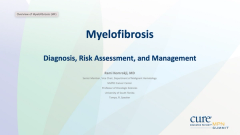
Educated Patient® MPN Summit Risk Stratification and Management of MF Presentation: May 20, 2023
Watch Dr. Rami Komrokji, from Moffitt Cancer Center, discuss risk stratification and management of myelofibrosis during the CURE® Educated Patient® MPN Summit.
Episodes in this series

Determining the effects on overall survival and symptoms in patients with myelofibrosis can help care teams manage the disease and potentially impact outcomes, an expert said.
Dr. Rami Komrokji, vice chair of the department of malignant hematology and head of the leukemia and MDS section at Moffitt Cancer Center in Tampa, Florida, presented on risk stratification and management of myelofibrosis at the CURE® Educated Patient® MPN Summit.
Myelofibrosis is part of a group of primary blood cancers called myeloproliferative neoplasms, according to the presentation. Although it is the most symptomatic out of the group, it is not the most common, affecting approximately 16,000 to 18,500 patients in the United States.
What diseases like myelofibrosis have in common is that there are genetic mutations that lead to the activation of an inflammatory pathway, which results in the symptoms that patients experience. This is why cancer teams check for genetic markers via peripheral blood testing or bone marrow tests, which include markers like JAK2, CALR and MPL.
“We call them the phenotype driver mutations. Those are what drive many of the symptoms we see,” Komrokji said. “I always use the analogy: This is like a switch on the door. When we say it's mutant or abnormal, it means the switch is almost always on. That leads to many of the symptoms that patients experience.”
Myelofibrosis is a result of random genetic mutations — what Komrokji referred to as “mishappenings” — with unknown risk factors. But it is one of the most serious myeloproliferative neoplasms that impacts a patient’s overall survival (the time when a patient with the disease is still alive) over time. Patients with myelofibrosis also have a higher rate of the disease progressing to acute myeloid leukemia.
The symptoms patients with myelofibrosis experience can be categorized into different domains. For example, constitutional symptoms, which result from inflammation in the bone marrow, include fatigue, weight loss, night sweats, bone and joint pain, low-grade fevers, enlarged spleen (splenomegaly) or enlarged liver (hepatomegaly). Patients may also have low blood counts like anemia, thrombocytopenia (low platelets) and neutropenia (a subset of white blood cells that fight infection), all of which can increase a patient’s risk for infections.
Once a diagnosis of myelofibrosis is established, the cancer team will assess the risk of the disease to determine the types of symptoms it is causing, the risk for the disease to progress to leukemia and the potential impact on overall survival, Komrokji said. This is typically done through several methods like genetic profiling and blood draws to determine blood counts.
This information is used to categorize a patient’s disease as being higher risk or lower risk.
“As the name tells, a higher-risk group means that this disease has a higher chance of going to leukemia and may impact survival in the coming few years,” Komrokji said. “So for that group of (patients), we're thinking of more definitive treatment. (For) patients that are lower-risk disease, the disease is not going to impact the survival in the short term. So we gear the treatment for symptom improvement.”
Treatment Options
For most patients with higher-risk disease, doctors may consider an allogenic stem cell transplant, which Komrokji said is “the only curative option for our patients, (with) roughly around a 50% cure rate, which means we get rid of the disease (and) it does not come back at all, compared to 0% with any other option we do.”
Despite its potential effectiveness, stem cell transplantations are an intense treatment involving a month-long stay in the hospital, two-month stay at an apartment across the street from a hospital and a year-long effect on a patient’s quality of life, Komrokji said. There is also an estimated 10% to 20% risk for mortality from complications related to the procedure itself.
“We are always weighing the potential benefit and the cure versus the potential risk and … the short-term impact on the quality of life,” he said. “But if patients have … higher-risk disease, which means the disease is going to impact survival in the coming few years, and if the patients have no major comorbidities, no other medical problems, they are in good shape, then we are thinking of and offering the transplant.”
A focus of symptom management for most patients with myelofibrosis is spleen enlargement, which may be treated with JAK2 inhibitors. The first JAK2 inhibitor that was approved by the Food and Drug Administration was Jakafi (ruxolitinib), which has been used for many years.
“If patient’s blood counts — particularly the platelets — are high enough, (Jakafi) is still our mainstay to reduce the spleen,” Komrokji said.
Inrebic (fedratinib) may be an option as a second-line treatment if Jakafi no longer works in managing myelofibrosis, as long as patients have “good blood counts,” Komrokji added. If a patient’s blood counts indicate low platelets, then patients may be treated with Vonjo (pacritinib), another FDA-approved JAK2 inhibitor.
A fourth JAK2 inhibitor — momelotinib — is not yet approved by the FDA, “but we hope that approval will be coming soon for our patients,” he said.
Reducing Spleen Size
Komrokji noted that there currently is a debate on whether there is a benefit in reducing the spleen size and how much it should be reduced by.
“I think we have clear data nowadays that spleen reduction does correlate with improvement in the outcome. And most people suggest that at least a 25% reduction in the spleen volume is enough,” he said.
He added that in the past, he typically did not treat patients with a focus on spleen size reduction unless they had clear symptoms related to it. But now, he said after observing patients with large spleens for a while, they may experience several liver-related complications like pressure onto the organ, abnormalities, cirrhosis and an accumulation of fluids in the abdomen.
“Nowadays, when patients have either symptoms or a sizable spleen, I’m more likely to discuss starting the treatment in the patients,” he said. “And the goal — at least — is to have a 25% reduction in the spleen volume, which in many studies seems to correlate with improvement in the outcome.”
For more news on cancer updates, research and education, don’t forget to











